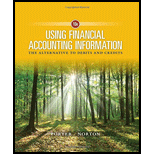
Using Financial Accounting Information
10th Edition
ISBN: 9781337276337
Author: Porter, Gary A.
Publisher: Cengage Learning,
expand_more
expand_more
format_list_bulleted
Question
Chapter 2, Problem 2.5.3AAP
To determine
Concept Introduction:
To indicate: The suggestions for the company to pay its bill on time.
Expert Solution & Answer
Trending nowThis is a popular solution!

Students have asked these similar questions
Expand upon it and add more info
JH, Inc., is a calendar year, accrual basis corporation with Joe as its sole shareholder (basis in his stock is $90,000). On January 1 of the current year, JH Corporation has accumulated E & P of $200,000. Before considering the effect of the distribution described below, the corporation’s current E & P is $50,000. On November 1, JH distributes an office building to Joe. The office building has an adjusted basis of $80,000 (fair market value of $100,000) and is subject to a mortgage of $110,000. Assume that the building has been depreciated using the ADS method for both income tax and E & P purposes. What are the tax consequences of the distribution to JH and to Joe? (In your answer, be sure to describe the effects on taxable income for both JH and Joe, the impact of the distribution on JH’s E & P, and Joe’s basis in the building.)
Joe is the sole shareholder of JH Corporation. Joe sold his stock to Ethan on October 31 for $150,000. Joe’s basis in JH stock was $50,000 at the start of the year. JH distributed land to Joe immediately before the sale. JH’s basis in the land was $20,000 (fair market value of $25,000). On December 31, Ethan received a $75,000 cash distribution from JH. During the year, JH has $20,000 of current E & P and its accumulated E & P balance on January 1 is $10,000. Which of the following statements is true?
a. Joe recognizes a $110,000 gain on the sale of his stock. b. Joe recognizes a $100,000 gain on the sale of his stock. c. Ethan receives $5,000 of dividend income.d. Joe receives $20,000 of dividend income. e. None of the above.
Chapter 2 Solutions
Using Financial Accounting Information
Ch. 2 - Prob. 2.1ECh. 2 - Prob. 2.2.1ECh. 2 - Prob. 2.2.2ECh. 2 - Classification of Financial Statement Items Regal...Ch. 2 - Prob. 2.4.1ECh. 2 - Prob. 2.4.2ECh. 2 - Prob. 2.4.3ECh. 2 - Prob. 2.5ECh. 2 - Prob. 2.6ECh. 2 - Prob. 2.7E
Ch. 2 - Prob. 2.8ECh. 2 - Statement of Retained Earnings Landon Corporation...Ch. 2 - Prob. 2.10ECh. 2 - Prob. 2.11ECh. 2 - Prob. 2.12MCECh. 2 - Prob. 2.13MCECh. 2 - Prob. 2.14MCECh. 2 - Prob. 2.1.1PCh. 2 - Prob. 2.1.2PCh. 2 - Prob. 2.2PCh. 2 - Prob. 2.3.1PCh. 2 - Prob. 2.3.2PCh. 2 - Prob. 2.3.3PCh. 2 - Prob. 2.4.1PCh. 2 - Prob. 2.4.2PCh. 2 - Prob. 2.5.1PCh. 2 - Prob. 2.5.2PCh. 2 - Prob. 2.5.3PCh. 2 - Prob. 2.6.1PCh. 2 - Prob. 2.6.2PCh. 2 - Prob. 2.7.1PCh. 2 - Prob. 2.7.2PCh. 2 - Prob. 2.7.3PCh. 2 - Multiple-Step Income Statement and Profit Margin...Ch. 2 - Prob. 2.8PCh. 2 - Prob. 2.9PCh. 2 - Prob. 2.10MCPCh. 2 - Prob. 2.11MCPCh. 2 - Prob. 2.12MCPCh. 2 - Prob. 2.1.1AAPCh. 2 - Prob. 2.1.2AAPCh. 2 - Prob. 2.2AAPCh. 2 - Prob. 2.3.1AAPCh. 2 - Prob. 2.3.2AAPCh. 2 - Prob. 2.3.3AAPCh. 2 - Prob. 2.4.1AAPCh. 2 - Prob. 2.4.2AAPCh. 2 - Prob. 2.5.1AAPCh. 2 - Prob. 2.5.2AAPCh. 2 - Prob. 2.5.3AAPCh. 2 - Prob. 2.6.1AAPCh. 2 - Prob. 2.6.2AAPCh. 2 - Prob. 2.7.1AAPCh. 2 - Prob. 2.7.2AAPCh. 2 - Prob. 2.7.3AAPCh. 2 - Multiple-Step Income Statement and Profit Margin...Ch. 2 - Prob. 2.8.1AAPCh. 2 - Prob. 2.8.2AAPCh. 2 - Prob. 2.9AAPCh. 2 - Prob. 2.10AAMCPCh. 2 - Prob. 2.11.1AAMCPCh. 2 - Prob. 2.11.2AAMCPCh. 2 - Prob. 2.12AAMCP
Knowledge Booster
Similar questions
- Please provide the accurate answer to this general accounting problem using appropriate methods.arrow_forwardPlease provide the accurate answer to this general accounting problem using appropriate methods.arrow_forwardI need help with this general accounting question using standard accounting techniques.arrow_forward
- Can you help me solve this general accounting question using valid accounting techniques?arrow_forwardCan you solve this general accounting question with accurate accounting calculations?arrow_forwardI am looking for the correct answer to this general accounting problem using valid accounting standards.arrow_forward
- I am searching for the accurate solution to this general accounting problem with the right approach.arrow_forwardCan you solve this general accounting problem with appropriate steps and explanations?arrow_forwardPlease explain the solution to this general accounting problem using the correct accounting principles.arrow_forward
arrow_back_ios
SEE MORE QUESTIONS
arrow_forward_ios
Recommended textbooks for you
 Financial Accounting: The Impact on Decision Make...AccountingISBN:9781305654174Author:Gary A. Porter, Curtis L. NortonPublisher:Cengage LearningPrinciples of Accounting Volume 1AccountingISBN:9781947172685Author:OpenStaxPublisher:OpenStax College
Financial Accounting: The Impact on Decision Make...AccountingISBN:9781305654174Author:Gary A. Porter, Curtis L. NortonPublisher:Cengage LearningPrinciples of Accounting Volume 1AccountingISBN:9781947172685Author:OpenStaxPublisher:OpenStax College College Accounting (Book Only): A Career ApproachAccountingISBN:9781337280570Author:Scott, Cathy J.Publisher:South-Western College Pub
College Accounting (Book Only): A Career ApproachAccountingISBN:9781337280570Author:Scott, Cathy J.Publisher:South-Western College Pub Financial AccountingAccountingISBN:9781337272124Author:Carl Warren, James M. Reeve, Jonathan DuchacPublisher:Cengage Learning
Financial AccountingAccountingISBN:9781337272124Author:Carl Warren, James M. Reeve, Jonathan DuchacPublisher:Cengage Learning College Accounting, Chapters 1-27AccountingISBN:9781337794756Author:HEINTZ, James A.Publisher:Cengage Learning,
College Accounting, Chapters 1-27AccountingISBN:9781337794756Author:HEINTZ, James A.Publisher:Cengage Learning,

Financial Accounting: The Impact on Decision Make...
Accounting
ISBN:9781305654174
Author:Gary A. Porter, Curtis L. Norton
Publisher:Cengage Learning

Principles of Accounting Volume 1
Accounting
ISBN:9781947172685
Author:OpenStax
Publisher:OpenStax College

College Accounting (Book Only): A Career Approach
Accounting
ISBN:9781337280570
Author:Scott, Cathy J.
Publisher:South-Western College Pub

Financial Accounting
Accounting
ISBN:9781337272124
Author:Carl Warren, James M. Reeve, Jonathan Duchac
Publisher:Cengage Learning

College Accounting, Chapters 1-27
Accounting
ISBN:9781337794756
Author:HEINTZ, James A.
Publisher:Cengage Learning,
